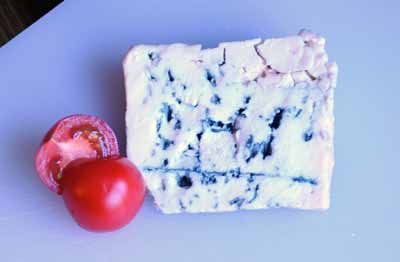Basajo would be a compelling cheese even if it didn't have such an engaging backstory. But the history behind this luscious wine-soaked blue adds to its allure, and its compatibility with silky dessert wines makes an even stronger case for a holiday splurge. Janet Fletcher wrote this great article in 2009.
Made with raw sheep's milk from Italy's Veneto region, Basajo is a new creation. But it emerges from a long tradition of aging wheels in grape must.
Who can know when and where this technique originated? La Casearia, the Italian company that matures Basajo and several other well-known "drunken" cheeses, such as Ubriaco, promotes one theory, which - surprise - ties the technique to the Veneto. I'm inclined to think the method of must-aging has deeper and broader roots than the La Casearia tale suggests, but here goes:
At the end of World War I, when the battle was raging in the Veneto, locals faced dire food shortages. Not only did they struggle to feed themselves, but they were expected to provide for the soldiers, too. Some ingenious farmer in the province of Treviso, hoping to hide a few cheeses, thought to bury the wheels in barrels of fermenting grape must. The wheels not only escaped discovery; they got even better.
The Carpenedo family behind La Casearia has resurrected the technique with great commercial success. For Basajo, the 2-kilo (roughly 4 1/2-pound) wheels spend about three weeks bathing in Passito di Pantelleria, a sweet wine from Sicily, which infuses the interior with a honeyed aroma. A few wine-plumped golden raisins cling to the outside of the wheel, which is cut in half for retail sale and foil wrapped.
I've tried the cheese only twice, and the two samples varied notably. Both "wept," or released moisture, at room temperature, not uncommon with blue cheeses. If that happens to your wedge, sponge it dry with a paper towel. In both instances, the interior paste was open, moist and creamy, with big pockets of blue. But the second sample was much bolder and boozier, with a mushy center that was beginning to break down. To my taste, it had passed its peak.
At its best, Basajo offers a seductive, velvety texture and mellow fruitiness, without the saltiness and peppery bite that turn many people away from blues. Be sure to ask for a taste to make sure the cheese is at a stage you like. In my limited experience, it declines rapidly in the fridge. Buy only what you plan to eat within a couple of days.
Accompany Basajo with ripe pears and a dessert wine with a comparably lush body. The cheese went fabulously with both the 1992 Dow Colheita Single-Year Tawny Port and the 1999 Kent Rasmussen Winery Late Harvest Riesling. Look for Basajo at Cheese Plus in San Francisco, A. G. Ferrari (multiple Bay Area locations), Oliver's Markets in Santa Rosa and Cotati, and Sunshine Foods in St. Helena.
http://articles.sfgate.com/2009-12-20/food/17331615_1_cheese-passito-wine
